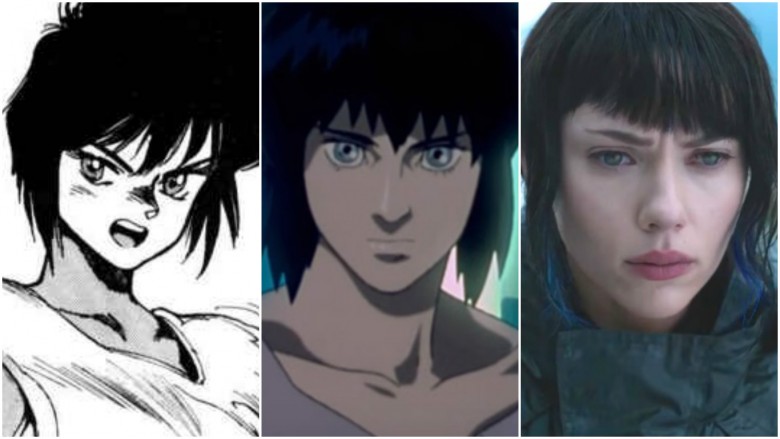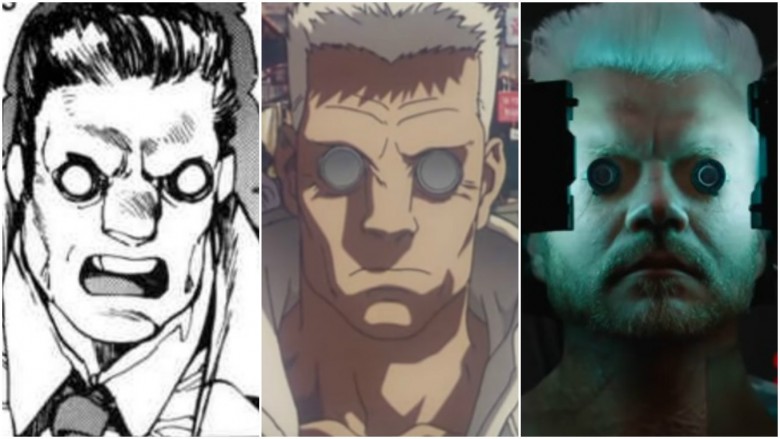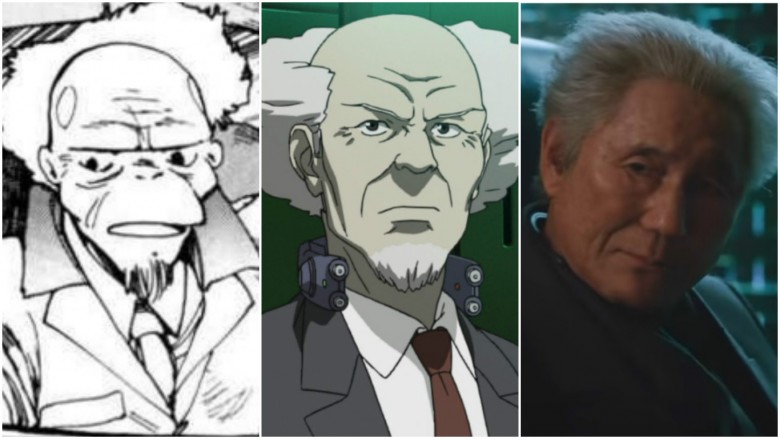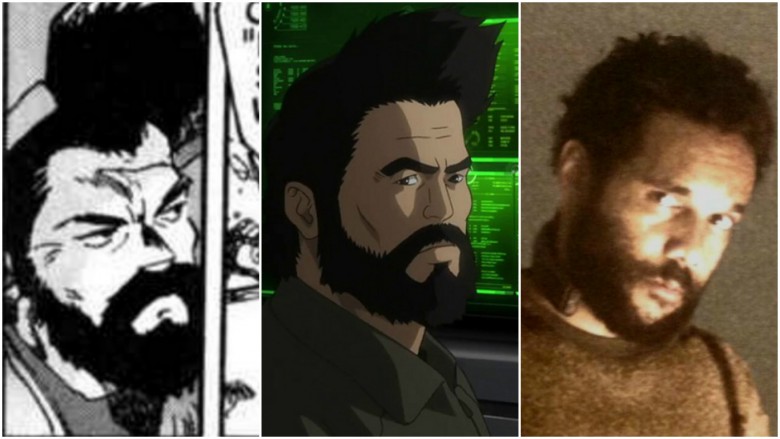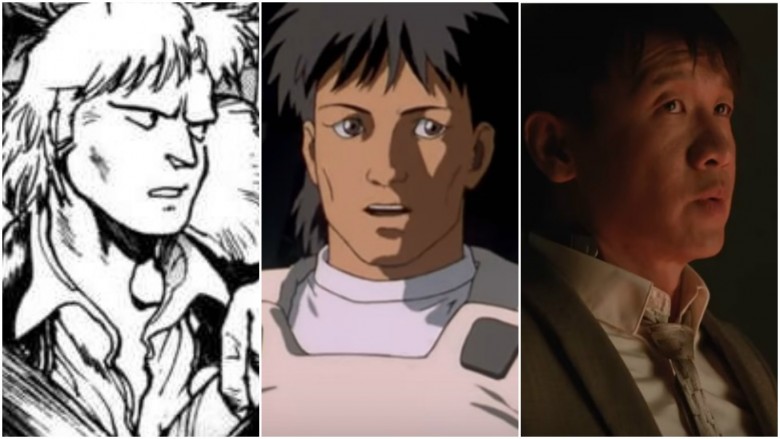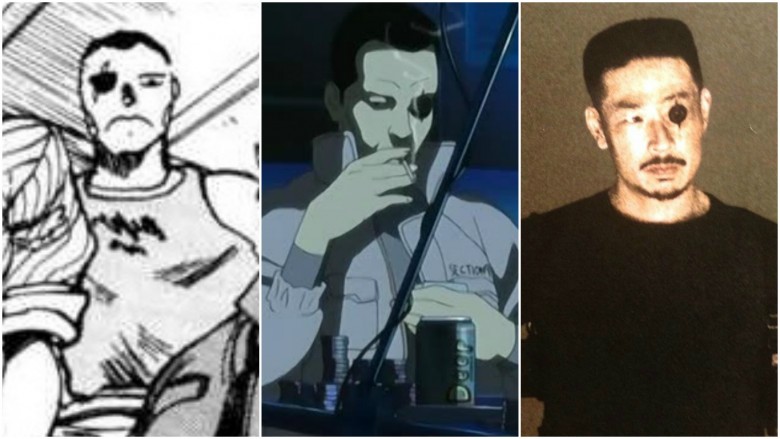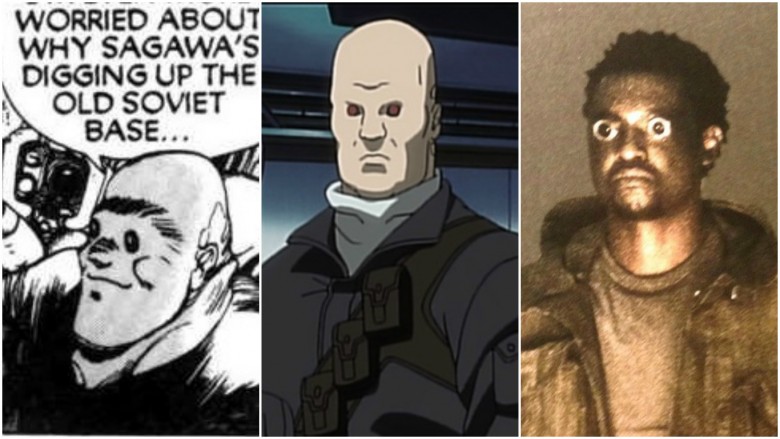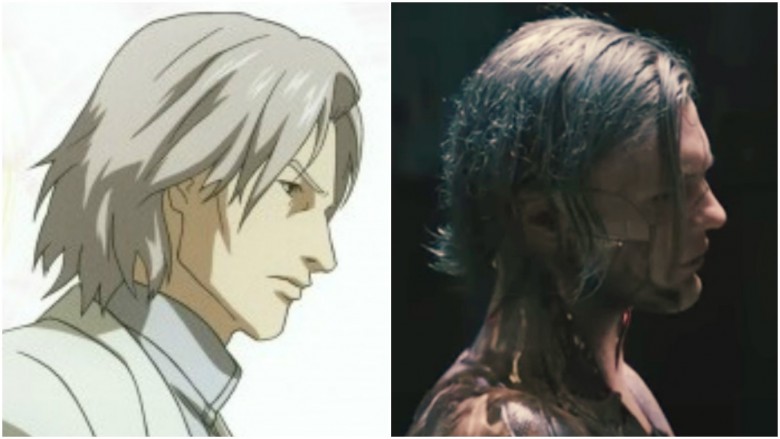How The Ghost In The Shell Characters Should Really Look
A lot has been said about the casting of Paramount's live-action Ghost in the Shell, though in truth the big-budget Hollywood adaptation of Masamune Shirow's legendary manga series isn't the first to deviate from the source material. Debuting in the pages of Young Magazine in 1989, Ghost has gone on to be adapted into several animated movies and TV shows, beginning with the 1995 feature length anime—the version with which many people are most familiar. At least, until recently.
The Scarlett Johansson-led remake has caused a major stir for all the wrong reasons, with accusations of whitewashing erupting the moment it was announced the American actress would be playing the lead in this distinctively Japanese property. Pressure has continued to build as the release date looms, and the filmmakers certainly haven't helped themselves. The studio left itself wide open for trolling by creating a meme maker that allowed users to make their own Ghost in the Shell posters. The results were damning, with most taking their chance to have a stab at the industry for giving yet another Asian role to a white star.
The verdict seems to be in when it comes to the leading lady, but what about the other members of the Section 9 special ops team? Do they match up to previous takes on the characters? Here's how they should really look.
The Major
Major Motoko Kusanagi is one of the best-known and most-loved characters in all of manga and anime, so a lot was riding on this casting from a fan-service perspective. The series protagonist is a converted cyborg (her only organic parts are her brain and spine) who first appeared in Shirow's drawings as a slightly immature gunslinger with bright pink hair and purple eyes. In the anime movies a different approach to the character was taken, with black hair and blue-grey eyes offering a downer makeover for the Major, who—thanks to the critical success of Mamoru Oshii's film—would become most recognizable as an emotionless killing machine.
This is the angle director Rupert Sanders and his team of writers have taken with their 2017 live-action remake, and it suits Scarlett Johansson well, with the actress having portrayed similar characters in Lucy, Under the Skin, and Marvel's Avengers movies. She'll pull off the Major's subtle sexuality without breaking a sweat, but we all know what the problem is here: it's the color of her shell. Johansson addressed the issue of whitewashing in an interview with Marie Claire, explaining she would "never presume to play another race of a person. Diversity is important in Hollywood, and I would never want to feel like I was playing a character that was offensive."
Remake rating: 1/10 – Despite having the "cyberpunk feel" about her, you can't escape the fact that Motoko Kusanagi isn't a New Yorker's name. Plenty of Japanese actresses with blockbuster experiences spring to mind as alternatives, including Rinko Kikuchi (Pacific Rim), Rila Fukushima (The Wolverine) and Chiaki Kuriyama (Kill Bill: Vol. 1).
Batou
Batou served as a sergeant in the military before undergoing his cyberization, after which he joined Section 9 as lead investigator. Over the course of both the manga and anime series, Batou develops feelings for the Major that, for the most part, remain unresolved, though his place as the franchise's most prominent male character has never changed. The same can't be said of his appearance, however, which has been tweaked from time to time. He's sported both a shaved head and a ponytail on occasion, though the short-tempered gearhead is best known for his white crew cut.
As we saw in the first trailer, Hollywood has opted to keep Batou short and trim just as he was in the 1995 anime, and the second trailer gave us our first glimpse of the character's most defining features—those aren't Morpheus-style, bridge-of-the-nose sunglasses he's wearing, they're Batou's cybernetic eyes. These disc-like objects used to bulge comically when Batou lost his cool in the pages of the manga, which remake actor Pilou Asbæk has been brushing up on. "[Batou] is an animated character, but the anime is based on a manga," the Danish star explained. "I based my character in Ghost in the Shell more on the original manga than on the anime."
Remake rating: 7/10 – It's funny that Asbæk should choose to base his take on Batou on the manga version of the character, as he more closely resembles that incarnation. Anime Batou is more of a towering jarhead, a man with a long face that gives nothing away. He pulls off the hairstyle and manages not to look stupid with the cybernetic eyes, though for a perfect score Asbæk probably needed more time in the gym.
Aramaki
Lt. Col. Daisuke Aramaki is the man pulling all the strings at Section 9, having created the specialist cyber-crime unit himself and personally recruited its members. In Shirow's manga he is often referred to as the "Old Ape" because, well, he looks like an old ape. Bald on top with crazy white hair sticking out at the back and sides like cotton candy, Aramaki's appearance has been a topic of discussion among Ghost in the Shell fans, with many speculating that it was based on Dusty the Coffin Maker from 1968 spaghetti western If You Meet Sartana Pray for Your Death. He made a few strides up the evolutionary scale in the animated movies and TV shows that followed, though his hair and billy-goat goatee remained.
Legend of Japanese cinema Takeshi Kitano takes on the character in the Paramount remake, in all likelihood recruited to bring some much needed respectability to the project. The Battle Royale star has confirmed he performed all of his scenes in his native tongue (with Johansson holding up cue cards so he knew when to chime in) which is all well and good, though the problem here is his appearance. The forever-young actor (can you believe this guy is 70?!) still carries himself like a younger man, and for all his tenacity, youth is not something you associate with Aramaki.
Remake rating: 5/10 – Kitano will no doubt make the role his own, but with a much rounder face that is minus one wispy beard, he doesn't much resemble the Aramaki Ghost in the Shell fans have come to know.
Ishikawa
Chain-smoking tech wiz Ishikawa isn't the most prominent member of Section 9, though he has history with the two top members of the team, having served with both the Major and Batou in the military prior to joining. The cyber warfare expert started out with a black bushy beard and an unkempt mess of hair in the first manga volume, and Production I.G never saw any reason to send him to the barber for a tidy up, keeping him looking rough and ready in their film and TV adaptations—"rough" being the operative word here.
As the oldest field operative on the team, Ishikawa has always been characterized a being a little haggard and less powerful than his allies, only joining a physical fight when it's absolutely necessary. Australian newcomer Lasarus Ratuere doesn't exactly fit the bill at first glance, and we're not talking about his Fijian heritage. Ratuere only recently hit his thirties and, judging by leaked promotional images of the cast and his Twitter page, he looks to be in pretty decent shape. This puts him at odds with the traditional image of Ishikawa, who looks every bit his age and is fond of cigars and whiskey over fitness. To top it off, Ratuere's hair and beard are nowhere near as wild as they ought to be.
Remake rating: 3/10 – Changing the beard from homeless to hipster is the chief complaint when it comes to Ratuere as Ishikawa, a casting that was most likely influenced by studio fears that audiences wouldn't accept a scruffy old-timer as a genius hacker.
Togusa
Shirow painted father of two Togusa as an emotional wreck at times, a beat cop turned Section 9 operative who struggles with self-esteem issues and insecurities about his ability to contribute to the cause. This side is less pronounced in the 1995 anime and indeed in subsequent adaptations, in which Togusa comes across as far more accomplished and confident—things he needs to be in order to pull off that mullet. While Togusa's hairstyle is the character's most recognizable feature, he's known for going retro from head to toe, with a fashion sense that often gets him teased by his teammates.
The first thing you notice about Chin Han's Togusa is his severely toned down mullet. The Chinese-Singaporean star addressed the issue of his character's iconic 'do in the run-up to Ghost in the Shell's release, revealing that it was "one of the looks that we worked on for quite a while. With a mullet, there's very different kinds of mullet. How big is the party in the back?... Rest assured, fans, we're going to have the mullet." But the party in the back looks like more a small gathering, and while the actor insisted the the "family man" side of Togusa would be respected, looks wise, he isn't much of a match.
Remake rating: 6/10 – The filmmakers get some kudos for at least attempting to bring the Togusa that Ghost fans have come to love to the big screen, though this is a case of round pegs and square holes. Han already has experience working on Hollywood blockbusters (he's appeared in The Dark Knight, Captain America: The Winter Soldier and Independence Day: Resurgence, to name a few) and this probably gave him the edge over younger, more visually suitable candidates.
Saito
Saito was nothing but a supporting character there to beef up the numbers in the manga series, and he didn't get an appearance in the 1995 feature-length anime, either. It wasn't until the Ghost in the Shell: Stand Alone Complex TV series that his character became something more than background furniture, with Production I.G deciding to make him Section 9's sharpshooter. Their version of Saito is a former mercenary who actually fought against the Major in Mexico, losing his left eye to her in battle (her bullet hit the scope of his sniper rifle and cut it to ribbons) before later joining her at S9 and having it replaced with an enhanced one.
Saito's most distinguishing feature is his hawkeye, a cybernetic ocular system that links with satellites to allow him unparalleled accuracy with his long-range weapon. In the English language version of the manga, his right eye is the one covered by a patch, though this is because the drawings were flipped during translation and Paramount got it right when they decided to stick with his left eye in their remake. That wasn't their only good decision regarding the character: Yutaka Izumihara's casting ticks all the boxes—the leaked images show that the Japanese actor has the Saito scowl down to a T.
Remake rating: 10/10 – No complaints here. Izumihara is something of an unknown quantity (he had minor roles in 2013's The Railway Man and 2014's Unbroken), but he looks as a close to a real-life Saito as you could hope.
Borma
You'd be forgiven for mistaking explosives expert Borma for Batou in some early volumes of the manga, being a big man with a pair of cybernetic eyes, albeit a different model and color. Like Saito, Borma was a minor supporting character in Shirow's work and was dropped from Section 9 altogether for the 1995 film, finally coming back into the fray in 2nd Gig, the second season of the Ghost in the Shell: Stand Alone Complex anime series. Unlike Saito, however, the powers that be at Paramount have taken a huge detour from earlier depictions of the character.
Borma's main distinguishing feature is his big bald head, and that's nowhere to be seen in the live-action adaptation, with the studio opting against casting a Kingpin-type skinhead and instead going with Zimbabwe-born New Zealander Tawanda Manyimo. Though he isn't a short guy at six feet tall, Manyimo doesn't have that bulking Borma build, and if you took away his red eyepieces, he'd be totally unrecognizable as the character.
Remake rating: 2/10 – Manyimo told The Standard that he brought the character to life during the audition stages, impressing enough to win the part despite a lack of any physical similarity. Whether his new take on the character is enough to make audiences forget the big bad Borma of the past remains to be seen.
Kuze
Hideo Kuze isn't the most famous antagonist from the Ghost in the Shell universe—that accolade belongs to the Puppet Master, focus of Section 9's investigations in the manga series as well as the 1995 anime. Kuze is more of an activist than a straight-up villain, walking that line between freedom fighter and terrorist as he leads Japan's disenfranchised refugee population in a resistance movement. Not a manga original, Kuze came into play during the Ghost in the Shell: Stand Alone Complex series, though the Kuze played by Michael Pitt won't be solely based on that character.
"Kuze borrows a few facets from different characters in the series," director Rupert Sanders told Collider. "He's a kind of amalgamation, so the way he moves through the network and stuff is borrowed from other elements. He's kind of our own creation, and Michael Pitt was incredibly immersed in that world. He went fully in there, he was living in a shipping container next to the set so he could smoke and punch punching bags simultaneously... he really immersed himself in the violence of the man and I think it's an incredible performance."
Remake rating: 6/10 – The filmmakers kept images of Pitt's Kuze under wraps, though glimpses in the second trailer reveal he has a far more artificial look than the animated Kuze. Despite that, the shape of his face matches up, as does the hairstyle. The jury is out on this one, but if Pitt's performance is as "incredible" as Sanders is claiming, the subtle differences won't matter in the end.

